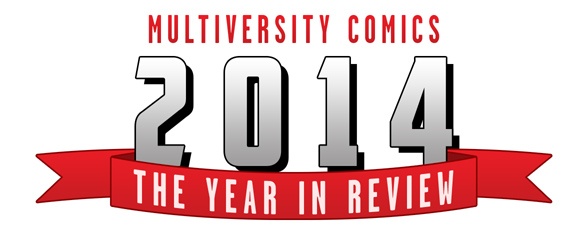
Even as minis become less and less popular in comics, we continue to see a bevy of excellent choices each and every year. 2014 was no different, including surprising digital comics, resurgences from long-time favorites, thrilling takes on new versions of familiar tales, and one long awaited comic that is near and dear to our hearts. But what were our favorites?
You can only find out below, as we rank the ten best minis of 2014. Take a look, and please share the ones you loved in the comments.
Note: All of Multiversity’s 2014 in Review awards are based off of all of the contributing writing team voting to decide each rank. Every list is combined with equal points for every voter, and the results are what you find below.
Looking for the rest of our 2014 in Review entries? Find them all here.
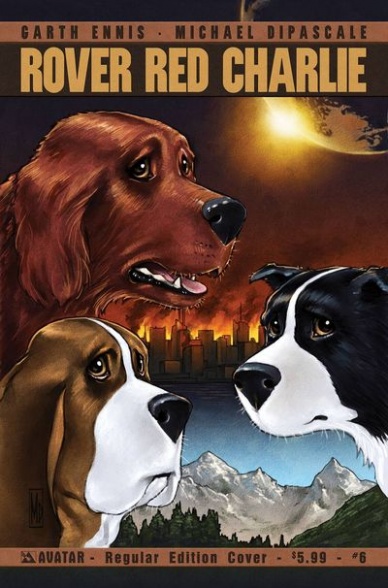
10. Rover Red Charlie
Why it made the list (David Harper): I’ll be totally honest, Avatar has never really been my cup of tea. But every once in a while, they really hit the spot, and it’s typically the books written by Garth Ennis. Like “Chronicles of Wormwood” before it, this book finds Ennis at his darkly humorous best, but “Rover Red Charlie” was even better than that. It’s more akin to his work on “Preacher” (my favorite comic ever) and “Fury MAX” in that it has the darkness and humor, but it is all built out of very real emotion and humanity.
Which is funny, as this story is about the dogs of the apocalypse. And by that, I mean three dogs named – you guessed it – Rover, Red and Charlie as they try to survive in a world where the feeders all went nuts and started killing each other. While it’s apparently the “Crossed” universe they live in, you don’t need to read that comic to enjoy this book greatly, as I never did and I still loved the hell out of this comic. It’s honestly one of the most emotionally rewarding yet grueling reads of the year, and artist Michael Dipascale deserves a lot of credit while we’re talking about it. His art is realistic enough to ground the tale but light enough to make the weight of the world and story burn us as we move along. He’s a perfect addition, and his work on Rover, Red and Charlie turns these canines into some of the most expressive and engaging characters of the year.
It may have finished #10 on our list, but “Rover Red Charlie” was very much my favorite mini-series of the year. It comes highly recommended.
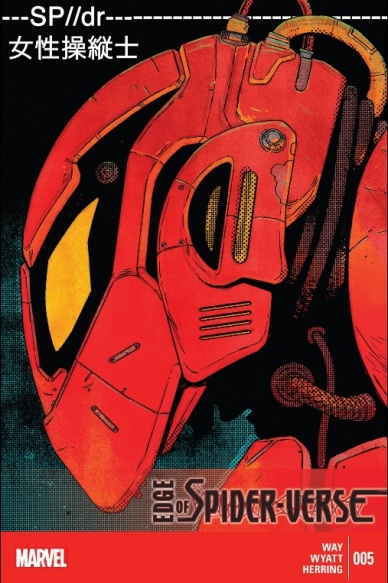
9. Edge of Spider-Verse
Why it made the list (James Johnston): There were never a lot of doubts that “Spider-Verse” wouldn’t be at least some sort of enjoyable. Hell, Marvel could have just sold it as Peter Parker, Miles Morales, and Spider-Ham teaming up to fight against The Inheritors and it would already be solid. Yet, over the course of the five issues of “Edge of Spider-Verse”, various creators came together to really flesh out the worlds of these random Spider-Men and Women. Thanks to this series, the Spiders in this mini-series became more than just background characters, but heroes with fully fleshed out universes.
More than just supporting the event though, “Edge of Spider-Verse” brought us two important things. First, Spider-Gwen debuted and absolutely slayed all comic book fandom by being one of the most immediately likable heroes of all time. The impact she made in this issue was huge, and led to her almost immediately getting her own spin-off series. That said, it’s not like the other spiders weren’t great either. All of them were rather interesting looks into the spider-legacy that were truly inventive, especially the fourth issue which offered a horrific EC Comics take on Peter Parker. This mini-series not only helped expand the Spider-Verse but created many characters readers instantly connected with and turned the extras of the “Spider-Verse” crossover into heroes in their own right.
As for that second thing, Gerard Way wrote a comic book about an Evangelion Spider-Girl. How could it not end up on our end of year lists?
Continued below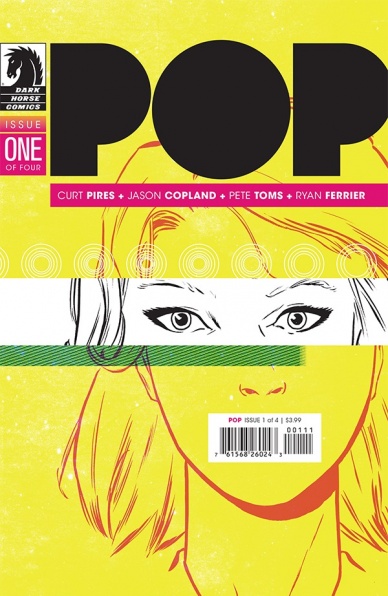
7 (tie). POP
Why it made the list (Brian Salvatore): Pop is a word with a million different connotations – it can be used pejoratively to take down something as being inconsequential or disposable, it can mean catchy and accessible, it can mean successful and well received. “POP” is sort of a combination of all of those things; it is presented in a very pop format (the comic book), its visual look owes a bit to pop art, and the story is, at least partially, about pop music. But then the book strips away all of that and becomes a story about things that are anything but trivial. The art by Jason Copland takes the story to a very stylized place, strongly rooted in reality, but touching on so many interesting and dangerous parts of human life. Copland and writer Curt Pires both elevated their work to new levels on “POP,” and I can’t wait to see what they do next.
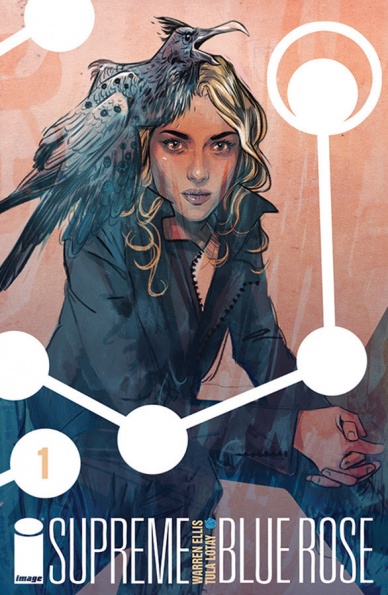
7 (tie). Supreme Blue Rose
Why it made the list (Vince Ostrowski): If you try to tell me that “Supreme: Blue Rose” was confusing, I won’t argue with you much. Instead, I’ll tell you to stick with it until issue #4, where the entire concept behind the previous 3 issues is more or less explained in as much detail as you could hope for from cerebral scribe Warren Ellis. It’s at that moment that you fully realize what a beautiful deconstruction of the idea of the “reboot” this comic is. It’s doubly satisfying if you’ve read any of Alan Moore’s ’90s run on the title, though that isn’t required to appreciate the straight story being told. If it feels like it’s not “Supreme” at all, that’s by design. “Supreme: Blue Rose” depicts a mystery that largely hasn’t contained the Supreme fiction as we know it, but instead contains version of it that tears at the edges of the story.
But the true revelation of “Supreme: Blue Rose” was the incomparable art of Tula Lotay. It’s been a star-making, modern noir pop art effort from Lotay that is just as enigmatic as Ellis’ story itself. Hell, I would argue that it’s mostly responsible for that particular quality. At one point, reporter Diana Dane (the central figure of this particular “Supreme” story) asks herself if she’s in a dream. If she’s seeing her world the way we’re seeing it through Lotay’s wispy, muted rainbow-tinted glasses, we can’t blame her for thinking that. And though Dane doesn’t have much time to stop and smell the roses, readers of “Supreme: Blue Rose” should, because it was one of the year’s most gorgeous books.
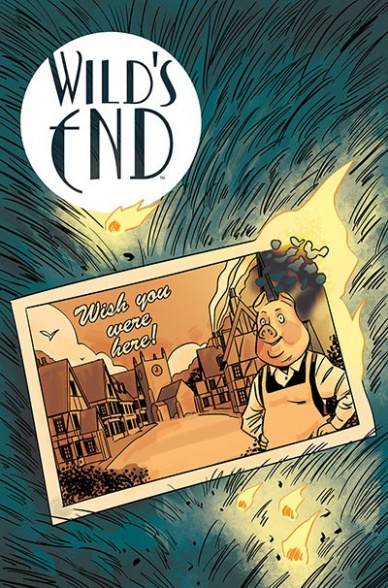
6. Wild’s End
Why it made the list (Mike Romeo): I’m sort of a mark for stories with anthropomorphic characters. Put Dan Abnett and INJ Culbard on it and now there’s no way I can turn it down. Wild’s End explores a quaint village in the English countryside circa 1930. Shortly after a war veteran settles into a new life in town, a star falls from the sky and tiny, tentacled robots begin incinerating everyone’s friends and neighbors.
This is exactly the type of story Dan Abnett excels at. He chooses common characters from familiar settings and drops a healthy dollop of insanity onto their little world. Abnett is able to sell us enormous ideas by showing us how the mundanity of day-to-day life is forever altered. In a lot of ways Culbard is the perfect artist to pair with that type of writer. His storytelling is clean and clear, making use of a well-honed shorthand for expression and motion. Culbard’s figure work and environments feel like real characters from real places. While there are plenty of fantastical elements in Wild’s End, nothing ever feels out of place. When you consider that this is a story about people with animal heads, living in the English countryside, defending themselves from robotic-alien-squid-things, believability begins to feel like a tall order. But Culbard does it.
Even though this feels like a comic that’s been tailor-made for me, Wild’s End is better than I could have hoped it’d be. At times it’s humorous, at others it can be completely heartbreaking. It’s thoughtful, pitch-perfect storytelling made it a shoo in for best of the year.
Continued below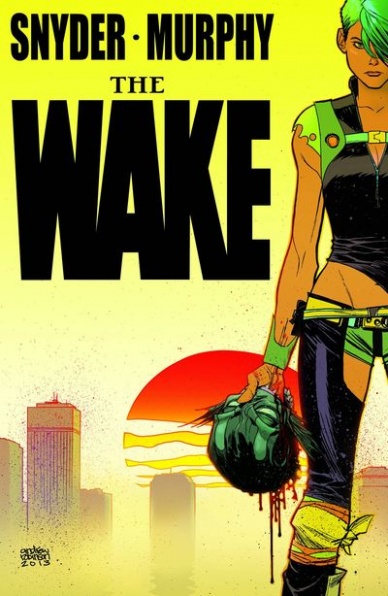
5. The Wake
Why it made the list (Matthew Garcia): Technically, “The Wake” started last year, and it was included on the Best of 2013 list as well, but thanks to Vertigo’s far more lax schedule, and the two distinct parts of the story, it’s like we got another whole book this year. Also, the second half of the series is mostly better than the first. I think a lot of this comes out because Scott Snyder and Sean Murphy are so clearly having more fun with this part of their story. They’ve jumped forward 200 years into the future, trading the claustrophobic horror for a pulp post-apocalyptic adventure, bursting with phosphorescent colors by Matt Hollingsworth.
When I was reading the first part, I kept wondering how Snyder and Murphy were going to drag out the underwater rig sections to ten issues, and was relieved a bit when I discovered the back half of the series was a massive flash forward. For the second half, I found myself constantly wishing that there was a spinoff series or something to fully explore many of the scenes Snyder and Murphy only give us a glimpse at. We still get a lot of questions about our place in the world, and I liked that it’s explored through myth and folklore rather than some extra-terrestrial sciencey stuff. Of course, the very end left me staring at my book, going, “Huh. Seriously.” Yet everything before that has been strong, exciting, sometimes terrifying, and a lot of fun.
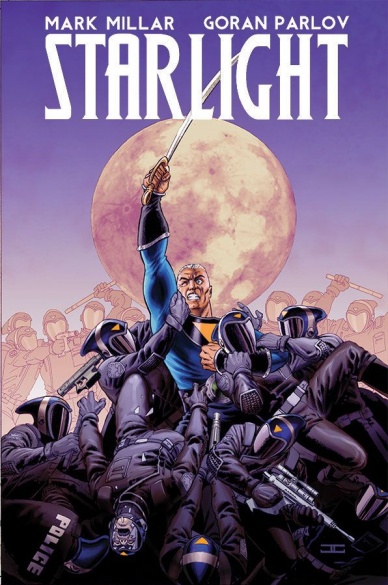
4. Starlight
Why it made the list (David Harper): While he’s easy to pick on for many readers, sometimes people forget that Mark Millar is a really, really tremendous writer. Or at least he can be, and in “Starlight”, his ode to Flash Gordon, John Carter and the pulp heroes of yesteryear, he’s at his very best.
Even with an emotionally wrenching (and beautiful) opening issue, “Starlight” is the type of good spirited adventure that many of us read comics for. People often complain about the grim and gritty nature of comics these days and how they’re perpetually stuck in their second act, but in these six issues, Millar and artist Goran Parlov, we’re given the complete tale of how Duke McQueen rediscovers the will to live in a journey of epic proportions. It’s a emotionally fulfilling tale, and by god is it a beautiful one.
And by that, I mean in a literal sense as Parlov is – in my estimation – one of comics’ greatest living artists. He fully embraces his European comic influences in this issue, and gives the book so much of its heart and power through his art. There are many times where Millar dials back the script and just trusts his collaborator to deliver the biggest story beats, and they make the moments all the more rewarding. Colorist Ive Svorcina gives the book a warm glow throughout, and its a partnership that even surpasses the work Svorcina did with Esad Ribic on “Thor: God of Thunder”. This book is an utter delight, and if you missed it, the trade is coming soon!
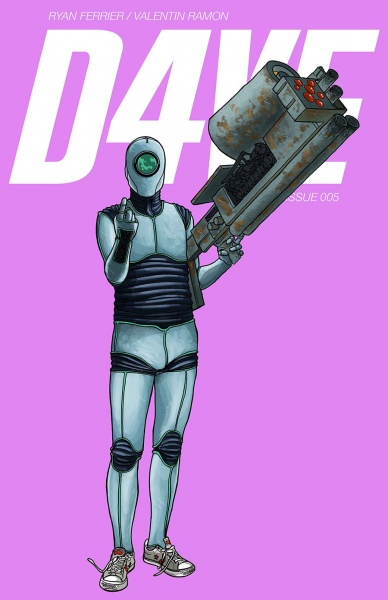
3. D4VE
Why it made the list (Brandon Burpee): D4VE was a fucking nuts ride. It had everything someone could want from a comics. It had robots, an alien invasion, phenomenal art and a story about being stuck in a rut and wanting to escape it that anyone can relate to. Ryan Ferrier and Valentin Ramon produced not only one of the best minis but titles of 2014. D4VE was my number one pick for best mini and D4VE #4 was my vote for the third best book of the year. That is how much I loved this book. Any book with robot masturbation has got my vote…I mean how could it not.
Why did I love D4VE so much? Well, there was not a title that made me laugh more than D4VE. From the dealings with his boss to the absurdly satisfying relationship with his son everything hit the mark for me humor wise. It was not only hilarious but also relatable as everyone has that time in their life where they question their station in the world. Granted, most of us don’t find our way in quite the same way as D4VE but you get the gist. Ferrier crafted some of the most hilarious situations and characters with this book and I really look forward to seeing what he brings to the table next.
Continued belowAs far as the art goes, Ramon went from being a total unknown, for me, to a must buy. He was able to bring some of the most ridiculous situations to life in a way that really elevated the writing. Humor writing can be tricky if the artist isn’t able to convey the humor but Ramon really brought the magic with scenes like the robot strip club. I mean, go back to that scene and take a look at what Ramon was able to do. So many little details that got me laughing so hard my chest hurt and my eyes watered.
D4VE was my jam in 2014, and in 2015, it’s coming to print. While I own all the digital issues, I will be buying it all again in print. I highly recommend that if you haven’t read D4VE that you buy the book up in print form. If you can’t wait though go check it out on Comixology. However you do it, read the damn book. You won’t be sorry.
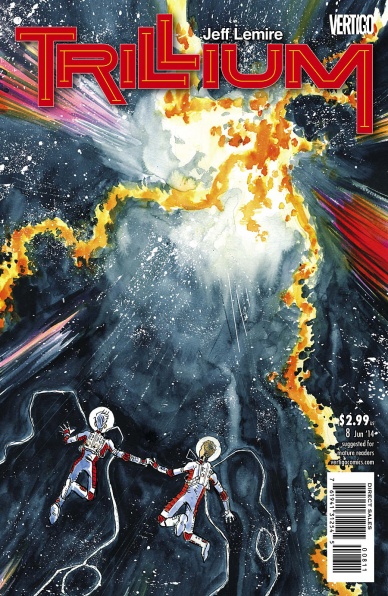
2. Trillium
Why it made the list (Drew Bradley): For a word that’s used so often, it’s really hard to be an innovative storyteller. Text, audio, and visual mediums have been around for centuries, and even newer versions of minstrels and theater troupes like radio and film have been around for a few generations now. Most of the ground breaking achievements occur early in a medium’s existence, and then it’s just a matter of refining and improving the previous material. Lately, it seems like the threshold for being innovative is to come up with a new iteration of “X meets Y, set in blank.” Then Jeff Lemire comes along and reminds everyone what the word “innovative” really means.
The plot for “Trillium” by itself wouldn’t have ranked on my top 10 list for the year. It was engaging, sure, but I could easily name ten books whose storyline interested me more. The reason “Trillium” is on this list is how it was told. Lemire utilized elements unique to comics and serial storytelling to make reading each issue a true experience. He took concepts used by others as gimmicks, like a flip book, and he made them integral to the narrative. In the second issue, he used the panel gutters to immerse you in the characters’ mindsets. Alas, some of the magic that made “Trillium” so amazing was lost when it was collected into a single volume. If you missed these eight issues as they came out, you need to track them down individually.

1. The Multiversity
Why it made the list (Matthew Meylikhov): Back in May 2009, a younger version of myself debated between two names for the site between two (then) otherwise esoteric references: either the name of a place in comics long forgotten, or a name of a hypothetical comic supposedly coming out later in the year. Five years later, “The Multiversity” actually debuted — and to say that it has been worth the wait is to perhaps put it lightly, though I and the royal we are clearly a very biased party.
“The Multiversity” is a comic book about comic books, and the care and craft that has been put into the series over the past five years is fairly evident. From the bombastic and fun debut issue through the various one-shots that have made up the run of the series, Morrison and a bevy of excellent artists like Frank Quitely, Chris Sprouse and Ben Oliver have been giving their all to the series in what could very well be the highlight of comics that we get to write about. A dense series that is just rife with commentary about the medium, this book perhaps more than any other has both taken comic trends to task while putting the sequential art form on a pedestal, and using that plateau to show that comics more so than any other medium of entertainment is the best.
Years from now, I imagine people will talk about “The Multiversity” in the same way they talk about other landmark comic books of our era. In fact, I’d wager that this book could literally become the book to hand to people to show why comics are so wonderful. The first half of it that we’ve gotten in 2014 has been an absolute highlight, and if it takes five years to get a comic book series like this then I’ll happily wait longer than Fry’s dog Seymour for every comic series from Morrison et al in the future.






